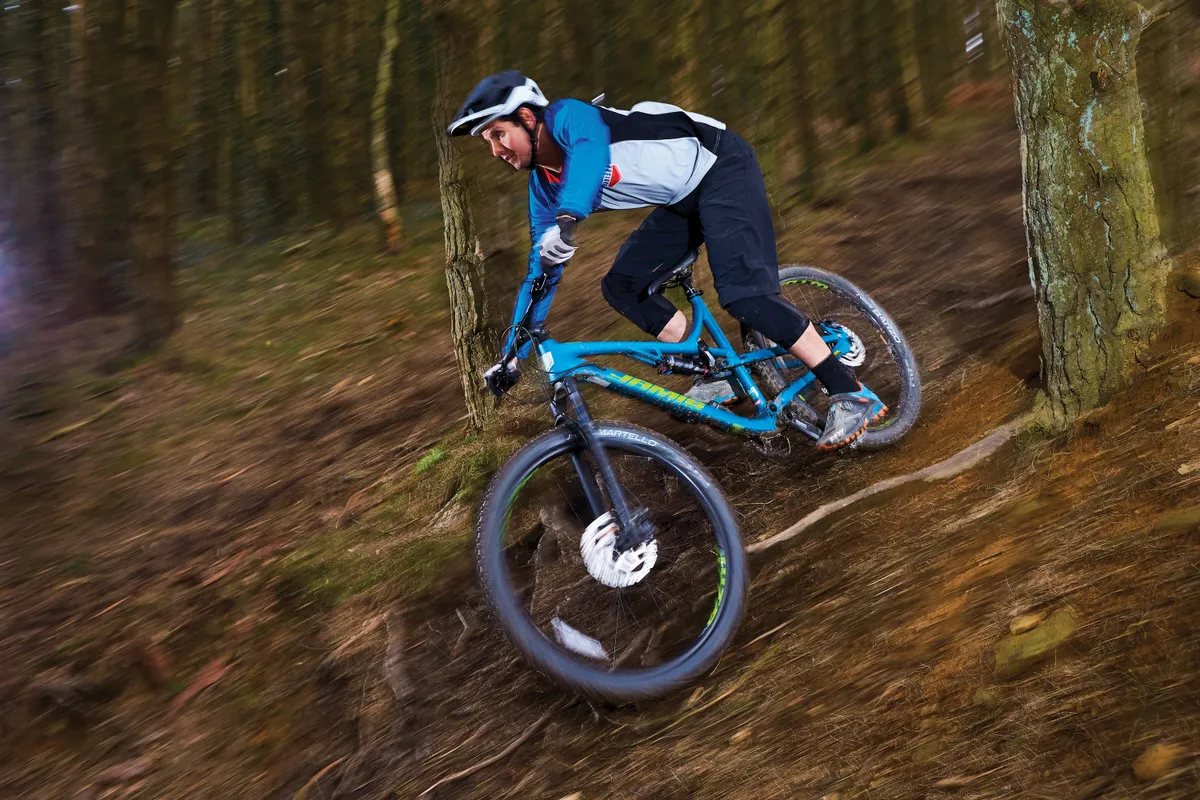Looking at the Jamis Dakar, you’d be forgiven for thinking it costs several hundred quid more than it does, with 12-speed gearing and branded parts throughout. It’s a shame the chassis they’re bolted to has slightly outdated geometry that’s more suited to climbing than all-round trail riding.
The relatively simple-looking frame is functional but fairly attractive for a bike at this price, with no ugly pigeon-poo welds or funky lines. Jamis’s mp2 suspension pairs a single-pivot swingarm with a linkage to actuate the top-tube-mounted shock.
The rear triangle is asymmetrical, with a dropped driveside chainstay to improve chainring clearance. A tapered head-tube boosts stiffness, a threaded bottom bracket (BB) makes maintenance easier, and there are ISCG-05 tabs for a chain guide.
The rear axle is the latest Boost 148 width (12 x 148mm), and all the cables, including the dropper post, are routed semi-internally.

Jamis Dakar A1 kit
At this price, I’d expect to see some own-brand gear, to keep costs down, but Jamis has worked miracles to fit almost exclusively branded kit.
RockShox’ Recon RL fork gets steel stanchions, but uses its low-friction ‘Fast Black’ finish. Damping is taken care of by its proven Motion Control system and, for a budget fork, I’ve no complaints.
The Monarch RL shock provides adequate control on descents and a lockout for climbs, which I didn’t need to use.
While SRAM’s NX Eagle drivetrain isn’t as smooth and positive-feeling as its higher-spec offerings, the wide-range 12-speed cassette is welcome on a bike you’ll likely spend all day riding, with the 50t largest sprocket providing a ‘get out of jail free’ card on climbs.
The bike has relatively narrow wheels and tyres, by modern standards. In this case, that means 2.35in Vittoria rubber on 25mm (internal) WTB rims. A zero-rise Race Face bar is paired with a short-ish 50mm stem.
Jamis Dakar A1 ride impressions
Throw a leg over the Dakar and the first thing you’ll notice is the low front-end and relatively high seat tower. These put you in a fairly traditional, XC-biased riding position.
This is accentuated by the flat bar and the short steerer tube on the fork, which limits how high you can raise the stem using spacers. Although the large size has a longer-than-average 463mm reach, its steep 68-degree head angle and short 735mm front centre combine to create a bike that feels relatively nervous on the descents, but comfy on the climbs.
The Dakar is exceptionally stable when ascending, whether seated or standing, and there’s a lockout on the shock for choppy pedallers. It feels even more at home powering along flat or slightly undulating terrain, where the supple suspension, grippy but not massively knobbly tyres, and dropper post all help you to maintain flow and speed where rivals with rigid posts leave you feeling constrained.

This competence on flat and uphill terrain comes at a price though. On gnarly, fast descents, the steep geometry, low front-end and high seat tower combine to make the Dakar feel rather unsettled.
The front wheel has a penchant for tucking under when the bike is pushed beyond cruising speed, which led me to overcompensate by hanging off the back, making the bike harder to control.
Even upping the fork pressure to 117psi (22psi over the recommended setting for my weight) didn’t reduce the forward-pitching and wheel-tucking enough to inspire confidence and let me take full advantage of the grippy tyres and solid-feeling wheels.
While the Jamis’s spec might suggest a bike that’s capable of taking on some rough, burly terrain, the geometry is definitely much better suited to flatter, more sedate rides.
Although, having said that, the Dakar A1 has some killer kit for the money, so if you’re not a particularly aggressive rider, this could still sway you to part with your cash.

Jamis Dakar A1 geometry (L)
- Seat angle: 75 degrees
- Head angle: 68 degrees
- Chainstay: 44cm
- Seat tube: 48.2cm
- Top tube: 62cm
- Head tube: 12cm
- Bottom bracket drop: 1.8cm
- Bottom bracket height: 33cm
- Wheelbase: 1,175mm
- Stack: 56.8cm
- Reach: 46.3cm
Product
| Brand | Jamis |
| Price | £1375.00, $2099.00 |
| Weight | 14.48kg |
Features
| Fork | RockShox Recon RL, 120mm (4.7in) travel |
| Stem | Race Face Ride, 50mm |
| Chain | SRAM PC-1170 |
| Frame | Triple-butted 6061 aluminium alloy, 120mm (4.7in) travel |
| Tyres | Vittoria Martello 4C TNT 27.5x2.35in (f), Vittoria Barzo 4C TNT 27.5x2.35in (r) |
| Brakes | Shimano MT400, 180/160mm |
| Cranks | SRAM NX, 32t |
| Saddle | WTB Volt 142 |
| Wheels | WTB STX i-25 rims on Formula hubs |
| Headset | FSA Orbit 1.5 ZS |
| Shifter | SRAM NX Eagle |
| Cassette | SRAM NX Eagle PG-1230, 10-50t |
| Seatpost | KS Eten-I 100mm dropper |
| Grips/tape | Jamis lock-on |
| Handlebar | Race Face Ride, 780mm |
| Rear shock | RockShox Monarch RL DebonAir, ‘M’ tune |
| Bottom bracket | SRAM |
| Available sizes | XS, S, M, L, XL |
| Rear derailleur | SRAM NX Eagle (1x12) |
